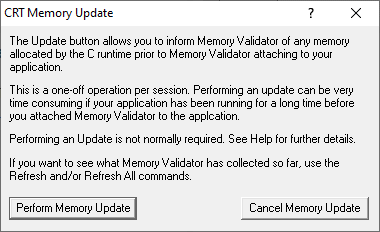Why is Update needed?
When Memory Validator attaches to a target program, some memory allocations may have been made already.
Although those allocations are typically in the very first startup code executed as the C runtime initialises, Memory Validator won't know their location.
This is true even when Memory Validator launches, waits for, or is linked to the target program.
Where the program has been running for a while and Memory Validator is injected into the program, then clearly a lot of allocations could have occurred already!
In most cases it's not important to know about the C runtime initialisation memory, as the C runtime will deallocate the memory when the program shuts down.
However, if you need Memory Validator to know about this memory you can use this update function to cause the stub to send information about all C runtime memory allocations to the Memory Validator user interface.
 These allocations won't have a stack trace to identify where the memory was allocated, but for the _DEBUG versions of the C runtime, there may be useful filename and line information.
These allocations won't have a stack trace to identify where the memory was allocated, but for the _DEBUG versions of the C runtime, there may be useful filename and line information.
Invoking a CRT memory update
Use one of the following methods to invoke an update:
 Tools menu
Tools menu  Update
Update  shows the CRT Memory Update dialog
shows the CRT Memory Update dialog
or use the Update icon on the Tools toolbar:

 Update is a one-off operation in each session. The option is disabled after the first time.
Update is a one-off operation in each session. The option is disabled after the first time.
The CRT Memory Update dialog
A confirmation dialog appears with a notice before the update proceeds.
